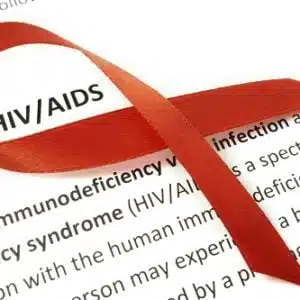Difficult History Should Not be Forgotten
We’re taking time to look back at the early history of HIV/AIDS in America.
Spread Knowledge, Not Panic
By the time the HIV/AIDS epidemic came to national consciousness in the 1980s, thousands of gay men were already infected and thousands more had already lost their lives. Let’s pause to re-visit the history of HIV/AIDS in America, paying homage to the generation of brothers, husbands, lovers, friends, artists, thinkers, and loved ones that we lost to this epidemic.
1981 – Gay Cancer
Our history lesson begins in the early 1980s. Accounts differ, but we know that HIV/AIDS existed before the 1980s, but without a name. In the early years of the 1980s, several cases of a rare lung infection, Pneumocystis carinii pneumonia (PCP), occurred in young, previously healthy, gay men in Los Angeles.
Additionally, several other cases of a rare cancer, Kaposi’s Sarcoma (associated with purplish patches of skin) also occurred in previously healthy, gay men in New York and California. Many of the men presented with other unusual illnesses, suggesting that their immune systems were not functioning properly.
Though similar cases were identified in heterosexual men and women in the early 1980s, the mysterious illness was labeled as “gay cancer,” and the media frenzy began. Fear set in as men infected with “gay cancer” started to die and more cases appeared. “Gay cancer” and its impact was presented by the media and many others as a righteous punishment to be paid by gay men for their homosexual lifestyle. As the disease spread, so did fear and panic. By then end of 1981, more than 150 identified cases had been reported. In response, the gay community started to mobilize.
1981/1982 – Gay Men’s Health Crisis
As news of the threat of “gay cancer” spread and as more and more men started to succumb to this mysterious new illness, members of the gay community took action. In late 1981, a group of gay men met in the home of writer Larry Kramer to discuss “gay cancer” and start collecting money to put toward researching the disease. This initial meeting was the foundation of what would eventually become Gay Men’s Health Crisis (GMHC), the first AIDS Service Organization in the United States. In 1982, the organization formed, starting with an answering machine in the home of volunteer Rodger McFarlane, which acted as the first AIDS hotline — receiving more than 100 calls the first night. GMHC continued and continues to support those impacted by HIV throughout the height of the HIV epidemic and still today.
1982 – AIDS Defined

While the vast majority of cases were found in gay men, some women, infants, blood transfusion recipients, intravenous drug users, and hemophiliacs were identified as having this mysterious new disease. Given the fact that in each case, the individuals were infected with other opportunistic conditions, not otherwise found in healthy individuals, it was determined that the new illness was somehow impacting the human immune system.
In 1982, the Centers for Disease Control published its first case definition for Acquired Immunodeficiency Syndrome (AIDS), describing it as “a disease, at least moderately predictive of a defect in cell-mediated immunity, occurring in a person with no known cause for diminished resistance to that disease.”
In addition to the case definition, the CDC released risk factors for AIDS, which included male homosexuality, intravenous drug use, Haitian origin and hemophilia. Though cases were identified in heterosexuals, more than 80 percent of cases were gay men, further fueling the public perception that AIDS was “a gay man’s disease.” By the end of 1982, there were 771 reported cases of AIDS and 618 AIDS-related deaths (80 percent death rate).
1983 – First AIDS Discrimination Case
As more and more people started to show signs and symptoms of AIDS, the discrimination against these individuals, and the gay community as a whole, began to mount. Gay men (regardless of whether they were infected) were turned away from hospitals, doctor’s offices, and a variety of public spaces for fear of contracting the disease.
These early years of the epidemic are haunted by stories of men being denied medical care, of meals for AIDS patients rotting outside hospital rooms because hospital staff refused to enter the room of an AIDS patient and of lovers and friends denied access to the bedside of dying partners.
In 1983, Dr. Joseph Sonnabend, a New York City doctor treating a number of AIDS patients was evicted from his office building because by the property company, which did not want AIDS patients in the building. With support from Lamda Legal, the first ever AIDS discrimination case was filed in People vs. West 12 Tenants Corps. The eviction was deemed a violation of human and civil rights law and the case paved the way legally for future legislation barring discrimination on the basis of HIV status. By the end of 1983, there were 2,807 reported AIDS cases and 2,118 AIDS-related deaths (75 percent death rate).
1984 – Discovering HIV

In 1984 two major scientific entities, the National Cancer Institute and the Pasteur Institute, collaborated on new findings and revealed they had both discovered the cause of AIDS, which is identified as a retrovirus that impacts the body’s immune cells. Later, they name the retrovirus HIV (Human Immunodeficiency Virus) and begin working on a blood test to identify the virus.
At the same time, Dr. Mathilde Krim, an early advocate for AIDS research and pioneer in AIDS-related immunology went before Congress to testify regarding the need for AIDS-related research funding, increased public awareness about the disease, and legal protections for individuals living with HIV/AIDS. By 1984, there were 7,293 reported cases of HIV/AIDS and 5,596 AIDS-related deaths (76 percent death rate).
Despite these statistics and despite outcry from activists around the country, the U.S. government had made little effort to address the epidemic. In fact, President Ronald Reagan had yet to use the word HIV or AIDS in a public statement, despite being almost half a decade into the national (and soon to be announced as global) epidemic.
1985 – Ryan White
In 1985, 13-year-old Ryan White, a teen from Kokomo, Indiana, was diagnosed with AIDS after receiving a contaminated blood transfusion. Shortly after his diagnosis, White attempted to return to school, but the school and surrounding community mounted protests, rallying against his attendance. Despite the fact that doctors from the foremost HIV/AIDS research organizations explained he posed no threat to other children, the fear, stigma, and misinformation about HIV/AIDS lead the community to rally against White and his family.
White’s family embarked on a long legal battle after he was banned from school and, although he was eventually readmitted, he and his family were continually met with cruel and sometimes violent backlash from the community. White was forced to eat his lunch with disposable utensils, use separate restrooms, and was prohibited from attending gym class.
Eventually, White and his family moved to a new town where they were welcomed by the community. White’s struggle gained national attention, sparked dialogue and research, and brought new perspective to the battle against HIV/AIDS. White’s story eventually led to the creation of the national Ryan White Program that supports uninsured or under-insured individuals living with HIV/AIDS.
By the end of 1985, there were 15,527 reported HIV/AIDS cases and 12,529 AIDS-related deaths (an 81 percent death rate). By this time, every region of the world has reported cases of HIV/AIDS.


